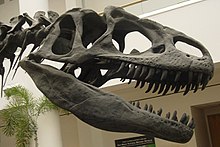異特龍超科[编辑]
| 異特龍超科 | |
|---|---|

| |
| 異特龍的頭顱骨,位於聖地牙哥自然歷史博物館 | |
| 科学分类 | |
| 界: | 动物界 Animalia |
| 门: | 脊索动物门 Chordata |
| 纲: | 蜥形纲 Sauropsida |
| 总目: | 恐龍總目 Dinosauria |
| 目: | 蜥臀目 Saurischia |
| 亚目: | 獸腳亞目 Theropoda |
| 演化支: | 新獸腳類 Neotheropoda |
| 演化支: | 鳥吻類 Averostra |
| 演化支: | 坚尾龙类 Tetanurae |
| 演化支: | 俄里翁龍類 Orionides |
| 演化支: | 鳥獸腳類 Avetheropoda |
| 下目: | †肉食龍下目 Carnosauria |
| 总科: | †異特龍超科 Allosauroidea Marsh,1878 |
| 模式種 | |
| †脆弱异特龙 Allosaurus fragilis Marsh,1877
| |
| 演化支[1] | |
異特龍超科(Allosauroidea)又譯躍龍超科,是獸腳亞目恐龍的一個超科或是演化支,包含以下四科:中棘龍科、鯊齒龍科、新獵龍科、以及異特龍科。異特龍超科擁有長而狹窄的口鼻部、大型眼眶、手部擁有三個手指、以及頭部上的角狀物與隆起物。異特龍超科之中,最著名也最為大眾所知的物種為北美洲的異特龍。
分類系統
[编辑]系統發生學
[编辑]異特龍超科演化支最初是在1993年,由菲力·柯爾(Phil Currie)與趙喜進所提出。在1997年,保羅·賽里諾(Paul Sereno)將異特龍超科使用為一個未定義的基群演化支。在1998年,保羅·塞里諾首次提出異特龍超科的基群定義:在新堅尾龍類之中,親緣關係接近於異特龍,而離新鳥亞綱較遠的所有物種。在2004年,湯瑪斯·霍爾茲(Thomas R. Holtz)與他的同事將異特龍超科定義為:包含脆弱異特龍(Allosaurus fragilis)與董氏中華盜龍,與兩者的最近共同祖先,以及最近共同祖先的所有後代。菲力·柯爾(Phil Currie)與肯尼思·卡彭特(Kenneth Carpenter)在2000年的研究,以及凱文·帕迪恩(Kevin Padian)在2007年的研究,都採納這個節點演化支。但在柯爾與卡彭特的研究中,鯊齒龍科與異特龍科、中華盜龍科之間的關係未定,因此該研究不確定鯊齒龍科是否為異特龍超科。
以下演化樹是根據Benson、Carrano、Brusatte等人在2010年研究[2]。:
| 異特龍超科 |
| ||||||||||||||||||
以下演化樹來自於2012年的堅尾龍類研究,不包含:雜肋龍、宣漢龍、扭椎龍[1]:
| Orionides |
| |||||||||||||||||||||||||||||||||||||||||||||||||||||||||||||||||||||||||||||||||||||||||||||||||||||||||||||||||||||||||||||||||||||||||||||||||||||||||
編號CPT-1980標本
[编辑]在西班牙阿拉貢自治區發現的一顆獸腳類牙齒齒冠,被標名為編號CPT-1980標本,存放於當地博物館。這個牙齒發現於Villar del Arzobispo組地層,地質年代相當於晚侏儸紀提通階到早白堊紀貝里亞階。
在2009年的一項研究,將編號CPT-1980標本、一顆發現於葡萄牙的異特龍超科牙齒互相比較,而這顆葡萄牙發現的牙齒長12.7公分。研究發現編號CPT-1980標本,估計完整身長約6到15公尺,是已知在西班牙發現的最大型獸腳類恐龍[3]。
參考資料
[编辑]- ^ 跳转到: 1.0 1.1 Carrano, M. T.; Benson, R. B. J.; Sampson, S. D. The phylogeny of Tetanurae (Dinosauria: Theropoda). Journal of Systematic Palaeontology. 2012, 10 (2): 211–300. doi:10.1080/14772019.2011.630927.
- ^ Benson, R.B.J.; Carrano, M.T; Brusatte, S.L. A new clade of archaic large-bodied predatory dinosaurs (Theropoda: Allosauroidea) that survived to the latest Mesozoic. Naturwissenschaften. 2010, 97 (1): 71–78. Bibcode:2010NW.....97...71B. PMID 19826771. doi:10.1007/s00114-009-0614-x.
- ^ R. Royo-Torres, A. Cobos, L. Alcalá. "Diente de un gran dinosaurio terópodo (Allosauroidea) de la Formación Villar del Arzobispo (Titónico-Berriasiense) de Riodeva (España) (页面存档备份,存于互联网档案馆)" Estudios Geológicos 65(1) enero-junio 2009.
- Currie, P. J., and X. Zhao. 1993. A new carnosaur (Dinosauria, Theropoda) from the Upper Jurassic of Xinjiang, People's Republic of China. Canadian Journal of Earth Sciences 30:2037-2081.
- Holtz, T. R., Jr. and Osmólska H. 2004. Saurischia; pp. 21–24 in D. B. Weishampel, P. Dodson, and H. Osmólska (eds.), The Dinosauria (2nd ed.), University of California Press, Berkeley.
- Sereno, P. C. 1997. The origin and evolution of dinosaurs. Annual Review of Earth and Planetary Sciences 25:435-489.
- Sereno, P. C. 1998. A rationale for phylogenetic definitions, with application to the higher-level taxonomy of Dinosauria. Neues Jahrbuch für Geologie und Paläontologie Abhandlungen 210:41-83.















